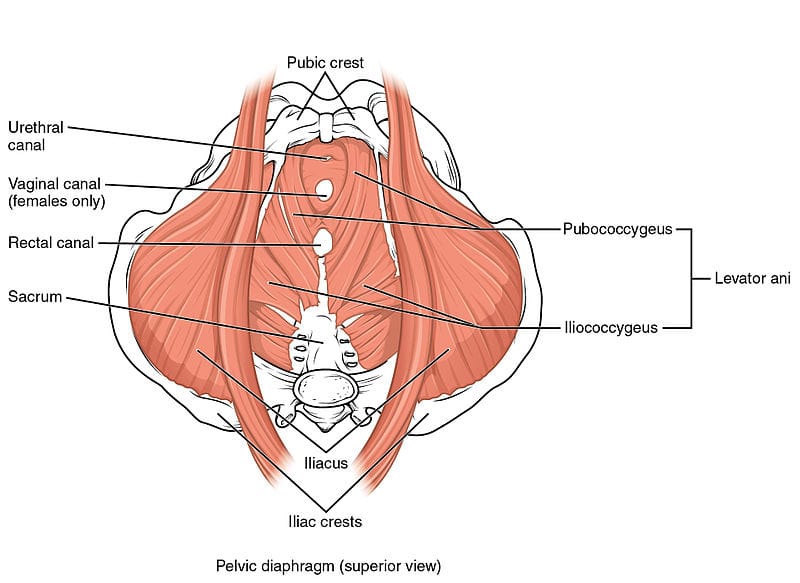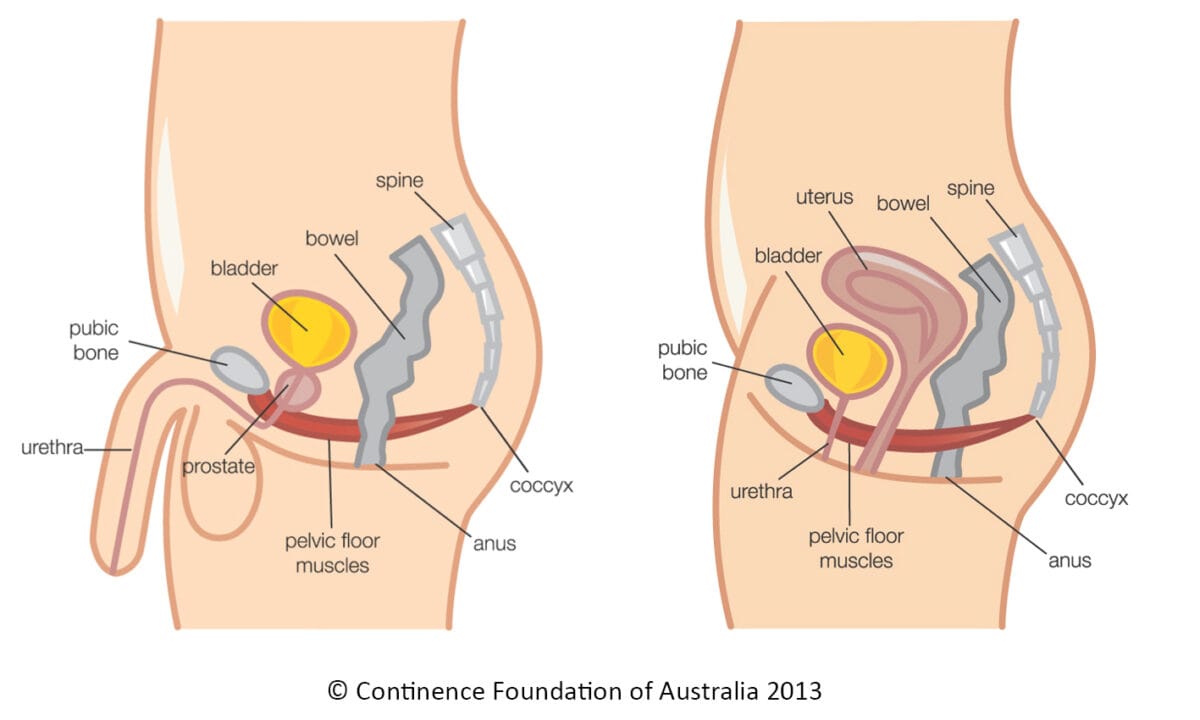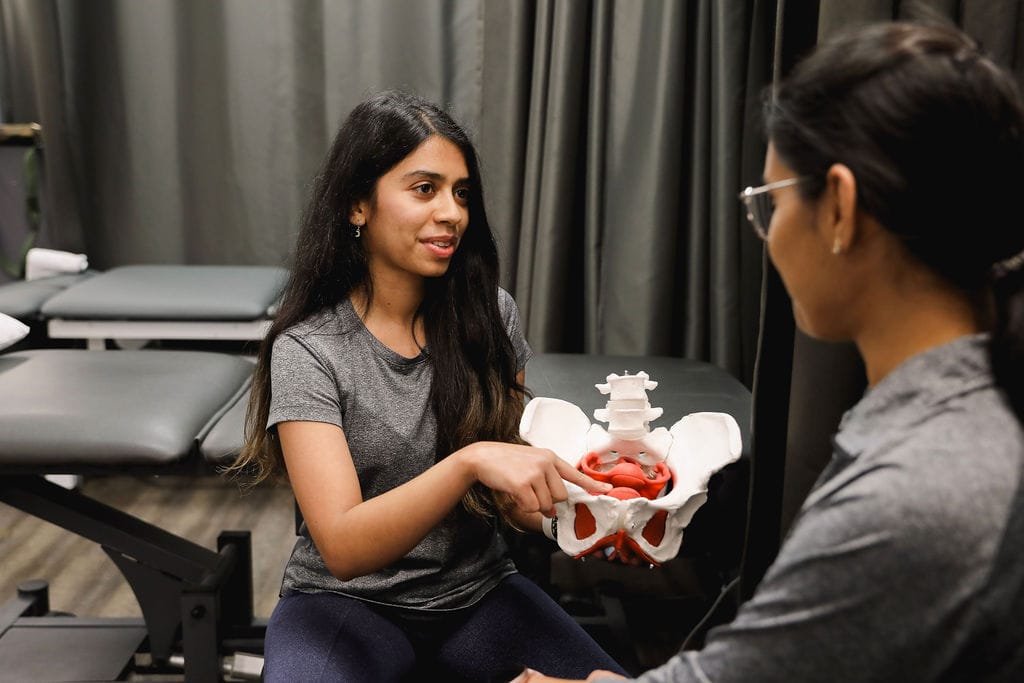Understanding the Pelvic Floor and Bladder Health
The pelvic floor consists of a group of muscles that support the bladder, bowel, and uterus (in women). These muscles are responsible for controlling urination, bowel movements, and sexual function. When weakened, common issues such as incontinence, pelvic organ prolapse, and sexual dysfunction can arise. Understanding the role of these muscles is the first step toward strengthening them.
Strengthening you pelvic floor can lead to a stress-free lifestyle. Schedule an appointment with one of the pelvic health physiotherapists at Triangle Physiotherapy.
Key functions of the Pelvic Floor:
- Support of pelvic organs
- Control of bladder and bowel movements
- Sexual health and satisfaction

Benefits of Strengthening the Pelvic Floor
By keeping your pelvic floor muscles strong, you can experience several benefits beyond preventing common issues like incontinence. Some of these include:
- Enhanced bladder control: Strong muscles prevent leakage during activities like sneezing, laughing, or exercising.
- Better posture: The pelvic floor is connected to core muscles, and strengthening it can improve your overall posture.
- Improved sexual function: Strengthening the pelvic muscles can lead to better sexual sensations and enhanced satisfaction.
- Postpartum recovery: New mothers can benefit from a stronger pelvic floor to regain muscle strength after childbirth.
Lifestyle Changes for Pelvic Health

Incorporating small but impactful changes in your daily routine can go a long way in improving pelvic floor and bladder health. Here are a few simple yet effective lifestyle adjustments:
- Stay hydrated but mindful of fluids: Drink plenty of water throughout the day, but reduce intake of caffeinated or carbonated drinks that can irritate the bladder.
- Maintain a healthy weight: Excess weight puts pressure on the pelvic floor, weakening it over time. Maintaining a healthy BMI can reduce strain.
- Eat a fiber-rich diet: Consuming enough fiber prevents constipation, which can stress the pelvic floor.
- Quit smoking: Chronic coughing caused by smoking weakens the pelvic floor muscles over time.
Strengthening your pelvic floor and bladder is a journey that requires consistency and dedication. By incorporating simple exercises, making mindful lifestyle changes, and considering professional or holistic support, you can enjoy better control, confidence, and overall well-being. Remember, prevention is always better than cure, so taking steps to support your pelvic health now will benefit you in the long run.
This lifestyle guide offers a comprehensive approach to strengthening your pelvic floor and bladder. By following these tips and making small adjustments, you’ll be well on your way to a healthier and stronger pelvic floor.
Contact us today to book an appointment with one of our pelvic health physiotherapists at either of our 8 locations and get your recovery journey started.
Pelvic pain can be a challenging and often misunderstood condition. It can significantly impact your quality of life, making it essential to understand your treatment options and management strategies. In this Q&A guide, we’ll explore the common questions surrounding pelvic pain and provide insights into how pelvic health physiotherapy can help.
What is pelvic pain, and what are its common causes?
Pelvic pain refers to discomfort or pain experienced in the lower abdomen, pelvis, or perineum. It can be acute (short-term) or chronic (lasting six months or more). The causes of pelvic pain are diverse and can include:
- Muscle dysfunction: Tight or weak pelvic floor muscles can lead to pain.
- Nerve conditions: Issues like pudendal neuralgia can cause significant discomfort.
- Gynecological conditions: Endometriosis, ovarian cysts, and uterine fibroids are common culprits.
- Urological issues: Interstitial cystitis or urinary tract infections (UTIs) can cause pelvic pain.
- Digestive disorders: Conditions like irritable bowel syndrome (IBS) and inflammatory bowel disease (IBD) may contribute to pain.
- Pregnancy and Childbirth
Understanding the underlying cause of your pelvic pain is crucial in determining the most effective treatment.

How can pelvic health physiotherapy help in managing pelvic pain?
Pelvic health physiotherapy is a specialized area of physiotherapy focused on the muscles, joints, and tissues of the pelvis. Here’s how it can help:
- Assessment and diagnosis: A pelvic health physiotherapist will conduct a thorough assessment to identify the root cause of your pain, including muscle strength, flexibility, and posture analysis.
- Manual therapy: Techniques such as myofascial release, trigger point therapy, and soft tissue mobilization can help alleviate pain by addressing muscle tension and improving circulation.
- Pelvic floor exercises: Tailored exercises can strengthen or relax pelvic floor muscles, depending on the nature of your pain.
- Education and lifestyle modifications: Understanding how daily activities, posture, and stress contribute to your pain can empower you to make changes that reduce discomfort.

- Biofeedback and relaxation techniques: These can help in retraining your pelvic muscles to function properly without causing pain.
What are the common treatment options for pelvic pain?
Treatment for pelvic pain varies based on its underlying cause but typically includes a combination of the following:
- Medications: Anti-inflammatory drugs, muscle relaxants, and nerve pain medications can provide relief.
- Physiotherapy: Targeted exercises and manual therapies can improve muscle function and reduce pain.
- Injections: Corticosteroid or anesthetic injections may be used to manage pain in specific areas.
- Surgical intervention: In some cases, surgery may be necessary to address structural issues or remove sources of pain, such as endometriosis lesions.
- Alternative therapies: Acupuncture, massage, and yoga can complement traditional treatments by promoting relaxation and reducing stress, which may exacerbate pain.
Your pelvic health physiotherapist will work with you to develop a personalized treatment plan that addresses your specific needs.
How long does it take to see results from pelvic health physiotherapy?
The timeline for seeing results can vary depending on the severity and duration of your pelvic pain, as well as your commitment to the treatment plan. Generally, patients may start noticing improvements within a few weeks of consistent therapy. However, chronic conditions may require several months of treatment to achieve significant relief. Your physiotherapist will regularly reassess your progress and adjust your treatment plan as needed to optimize your recovery.
Can lifestyle changes help manage pelvic pain?
Absolutely! Lifestyle modifications play a crucial role in managing pelvic pain. Consider the following:
- Posture: Improving your posture can reduce strain on your pelvic muscles and nerves.
- Diet: Certain foods can exacerbate pelvic pain, particularly if you have digestive issues. A balanced diet rich in anti-inflammatory foods can be beneficial.
- Stress management: Stress often exacerbates pelvic pain. Techniques like mindfulness, meditation, and breathing exercises can help manage stress levels.
- Regular exercise: Low-impact exercises, such as swimming, walking, or yoga, can improve overall muscle function and reduce pain.
Your pelvic health physiotherapist can guide you in making these changes to enhance your treatment outcomes.
When should I seek help for pelvic pain?
If you experience persistent or severe pelvic pain, it’s important to seek professional help. Early intervention can prevent the pain from becoming chronic and harder to treat. A pelvic health physiotherapist is an excellent first step, as they can assess your condition and direct you to the appropriate treatment options.
What should I expect during my first visit to a pelvic health physiotherapist?
During your first visit, you can expect the following:
- Detailed assessment: Your physiotherapist will ask about your medical history, symptoms, and lifestyle factors.
- Physical examination: This may include an external and internal assessment to evaluate your pelvic muscles, joints, and nerves.
- Discussion of goals: Together, you’ll set realistic goals for your treatment and the physiotherapist will create a treatment plan for you.
- Introduction to treatment: Depending on your assessment, your physiotherapist may begin treatment during your first session and provide you with exercises to do at home.
Navigating pelvic pain can be challenging, but with the right support and treatment, you can regain control over your health and well-being. If you’re struggling with pelvic pain, consider booking an appointment with a pelvic health physiotherapist to explore your treatment options.
Ready to take the first step?
If you’re experiencing pelvic pain and want to explore treatment options, contact us today to schedule a consultation with one of our experienced pelvic health physiotherapists.
Where can I find a pelvic health physiotherapist in Mississauga?
We have 2 locations with pelvic health physiotherapists in Mississauga to help you.



